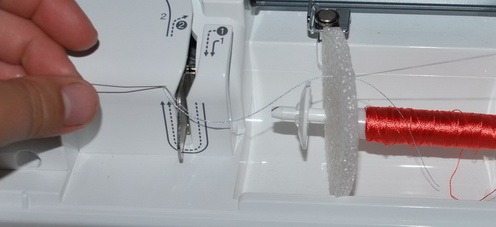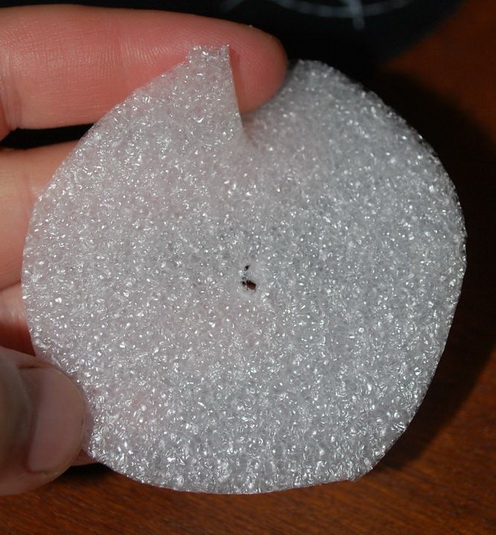Original text by Marina Belova
A long time ago I saw Deborah Jones' video on how to prevent metallic threads from twisting if you don't have a special net cover – using a small piece of Styrofoam. You can also couple it with the net cover for the combined effect. Styrofoam is that thing they put in packages to fill in the empty space when the item is smaller than the box, in order to prevent it from crumpling or breakage:

Debora's idea stuck in my memory, but I kept thinking why use Styrofoam at all – on commercial embroidery machines a metallic thread travels a long and complicated path and straightens out on the way. Only when confronted a home embroidery machine had I understood the necessity of this ploy, as thread tension regulation on those is a very confused matter, especially if you embroider with something more complex than an ordinary rayon or polyester thread.
The tricky thing was to obtain Styrofoam – I haven't received any packages for quite a long time. Suddenly an idea sprang to my mind: why not substitute it for the heat insulator with which I tried (unsuccessfully) to replace 3D Puff? In the end, this very material was used not only to solve the problem of twisting but also to adjust tension for the threads of any quality and structure.
As a result, the thread supply system on my home Brother now looks like this:

I cut a circle out of the insulator and put it on a spindle used for the small spools: At first, I drew the thread right through the circle by threading a needle and piercing:

But then, having grown weary of this, I made a small V-shaped cut and inserted the thread down to the very end. In this way:

I didn't register any difference in the quality of thread tension. All these methods work equally well. So, why all the undue effort?
Of course, I didn't spend money on special stands for driving threads from big spools to the machine or a machine that rewinds threads from big spools on small ones. All of this can be easily replaced by what is at hand. Instead of a rack, I use a belt hung from a shelf, with a binder clip through which the thread is driven. And the spool sits on the table, simple as that.
So much for this little gimmick. Now, this circle has a permanent residence on my machine and helps a great deal.
P.S. I think I've seen somewhere a piece of foam plastic used to the same effect.


There are no reviews to display.